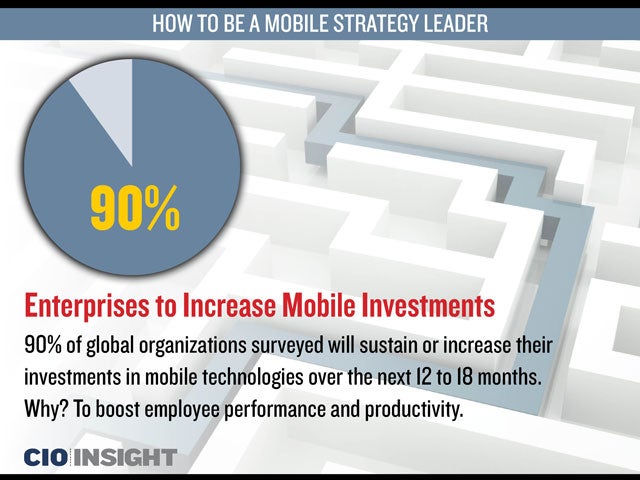
How to be a Mobile Strategy Leader
 Enterprises to Increase Mobile Investments
Enterprises to Increase Mobile Investments
90% of global organizations surveyed will sustain or increase their investments in mobile technologies over the next 12 to 18 months. Why? To boost employee performance and productivity.
 What Mobile Strategy Leaders Think
What Mobile Strategy Leaders Think
The IBM report examines mobile strategy leaders, a distinct subset of the respondents, in order to close the gap between leaders and peers. Only 14% of organizations surveyed are mobile strategy leaders.
 Mobile Strategy Leaders’ ROI, Business Impact
Mobile Strategy Leaders’ ROI, Business Impact
Of the mobile strategy leaders surveyed, 73% reported measurable returns on their mobile investments. 81% say mobile has changed how they do business.
 Going Mobile Is a Priority
Going Mobile Is a Priority
20% of organizations believe they have a superior or leading mobile strategy compared to their peers. 44% anticipate that their mobile strategy will supersede their peers’ during the next three years.
 BYOD Investments and Support
BYOD Investments and Support
66% of mobile strategy leaders are more likely to have adopted a BYOD approach for employees, compared to 32% of other organizations. Leaders are also more likely to support these programs with well-documented policies and IT support.
 Supporting Mobile Devices Isn’t Enough
Supporting Mobile Devices Isn’t Enough
To effectively support BYOD efforts, organizations should consider mobile use cases, such as access to apps and methods to improve customer service, according to the IBM report.
 Leading Three Mobile Challenges
Leading Three Mobile Challenges
The organizations reported their top three mobile challenges are:, Integrating mobile apps with systems: 54%, Implementing mobile security solutions for devices and apps: 53%, Reacting to changes in technology and mobile devices within a reasonable period of time: 51%
 Mobile Leaders: Analytical Ability
Mobile Leaders: Analytical Ability
Unlike their peers, mobile strategy leaders excel in analytics, timely delivery of information, system interoperability and security. In terms of analytics, 70% of mobile strategy leaders, compared to 37% of non-leaders, say they are effective in addressing structured and unstructured mobile data, analyzing mobile data, and taking action based on that data.
 Mobile Leaders: Timely Delivery of Information
Mobile Leaders: Timely Delivery of Information
Thanks to mobile devices, 58% of respondents say employee productivity has improved and customer response time is faster.
 Mobile Leaders: Ensuring System Interoperability
Mobile Leaders: Ensuring System Interoperability
70% of mobile strategy leaders say they have successfully ensured interoperability, leveraging APIs for external or cloud-provided data services, providing service-oriented architecture, and sharing information among systems and devices.
 Mobile Leaders: Security
Mobile Leaders: Security
79% of mobile strategy leaders report well-documented policies for employees using mobile devices, whereas 48% of non-leaders do so.